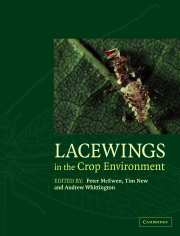Book contents
- Frontmatter
- Contents
- List of contributors
- Preface
- PART 1 Lacewing systematics and ecology
- PART 2 Lacewings in crops
- PART 3 Principles
- PART 4 Case studies
- Introduction to Part 4
- CHAPTER 18 Micromus tasmaniae: a key predator on aphids on field crops on Australasia?
- CHAPTER 19 Preliminary notes on Mallada signatus (Chrysopidae) as a predator in field crops in Australia
- CHAPTER 20 An evaluation of lacewing releases in North America
- CHAPTER 21 Chrysoperla externa and Ceraeochrysa spp.: potential for biological control in the New World tropics and subtropics
- CHAPTER 22 Comparative plant substrate specificity of Iberian Hemerobiidae, Coniopterygidae, and Chrysopidae
- CHAPTER 23 Lacewings in Sardinian olive groves
- CHAPTER 24 Lacewing occurrence in the agricultural landscape of Pianura Padana
- CHAPTER 25 Lacewings and snake-flies in Piedmont vineyards (northwestern Italy)
- CHAPTER 26 Control of aphids by Chrysoperla carnea on strawberry in Italy
- CHAPTER 27 Artificial overwintering chambers for Chrysoperla carnea and their application in pest control
- CHAPTER 28 Lacewings in Andalusian olive orchards
- CHAPTER 29 The green lacewings of Romania, their ecological patterns and occurrence in some agricultural crops
- CHAPTER 30 Biological control with Chrysoperla lucasina against Aphis fabae on artichoke in Brittany (France)
- PART 5 Conclusion
- Taxonomic index
- General index
CHAPTER 25 - Lacewings and snake-flies in Piedmont vineyards (northwestern Italy)
Published online by Cambridge University Press: 04 May 2010
- Frontmatter
- Contents
- List of contributors
- Preface
- PART 1 Lacewing systematics and ecology
- PART 2 Lacewings in crops
- PART 3 Principles
- PART 4 Case studies
- Introduction to Part 4
- CHAPTER 18 Micromus tasmaniae: a key predator on aphids on field crops on Australasia?
- CHAPTER 19 Preliminary notes on Mallada signatus (Chrysopidae) as a predator in field crops in Australia
- CHAPTER 20 An evaluation of lacewing releases in North America
- CHAPTER 21 Chrysoperla externa and Ceraeochrysa spp.: potential for biological control in the New World tropics and subtropics
- CHAPTER 22 Comparative plant substrate specificity of Iberian Hemerobiidae, Coniopterygidae, and Chrysopidae
- CHAPTER 23 Lacewings in Sardinian olive groves
- CHAPTER 24 Lacewing occurrence in the agricultural landscape of Pianura Padana
- CHAPTER 25 Lacewings and snake-flies in Piedmont vineyards (northwestern Italy)
- CHAPTER 26 Control of aphids by Chrysoperla carnea on strawberry in Italy
- CHAPTER 27 Artificial overwintering chambers for Chrysoperla carnea and their application in pest control
- CHAPTER 28 Lacewings in Andalusian olive orchards
- CHAPTER 29 The green lacewings of Romania, their ecological patterns and occurrence in some agricultural crops
- CHAPTER 30 Biological control with Chrysoperla lucasina against Aphis fabae on artichoke in Brittany (France)
- PART 5 Conclusion
- Taxonomic index
- General index
Summary
INTRODUCTION
Vineyards are an ancient Mediterranean agroecosystem, which spread all over the world in geographic areas with adequate climatic conditions. Wherever Vitis vinifera L. was introduced, it came into contact with new pests, such as the Nearctic phylloxerid Viteus vitifolii (Fitch) which also produced dramatic effects in the area of origin of this plant (Goidanich, 1960), and new biocoenoses were established (Vidano, 1988).
Grapevine pests are well known and have been thoroughly listed by Englert & Maixner (1992) for Europe, and by Delrio et al. (1989) and Pollini (1998) for Italy. Further studies on the main pests and their biocoenoses were made by Vidano (1988). On the other hand, only some guilds of useful insects have been studied in depth. This is the case, for example, of the parasitoids of Lobesia botrana (Denis & Schiffermüller) and Empoasca vitis (Göthe), about which there is a vast literature including, for the geographic area of our interest and for the many references cited, the papers by Vidano et al. (1988), Cerutti et al. (1989), and Marchesini & Dalla Montà (1994). Information on predators is on the other hand very scarce, and, with few exceptions, concerns mainly Orthoptera, anthocorids, mirids, and phytoseid mites (Duso & Girolami, 1983; Arzone et al., 1988; Camporese & Duso, 1996).
In most different geographic areas, lacewings are present on grapevines as predators of all the main groups of pests.
- Type
- Chapter
- Information
- Lacewings in the Crop Environment , pp. 471 - 480Publisher: Cambridge University PressPrint publication year: 2001



